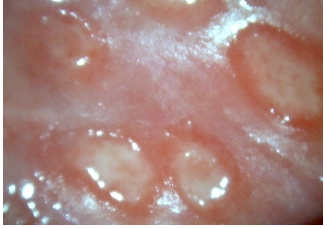Check out today’s Step 2 CK Qmax Question Challenge.
Know the answer? Post it in the comments below! Don’t forget to check back for an update with the correct answer and explanation (we’ll post it in the comments section below).
A 52-year-old man with chronic lymphocytic leukemia returns early from a camping trip in the northeastern United States because he has broken out in “hives.” He states he was hiking with his wife the previous day and began to notice large welts on his arms, legs, and face 4-6 hours after the hike. These welts have increased in number and severity. He states that they are itchy, but denies pain, fever, headache, nausea, and vomiting. Physical examination reveals two insect bites on the man’s arm and several patches of erythema. His WBC count is 41,000/mm³, hemoglobin is 10 g/dL, and platelet count is 125,000/mm³. Differential demonstrates 100% lymphocytes.
What is the most likely underlying pathogenesis of the patient’s “hives”?
A. Allergy to food consumed on the camping trip
B. Indolent chronic lymphocytic leukemia
C. Infection with Borrelia burgdorferi
D. Rapid-onset Rocky Mountain spotted fever caused by Rickettsia rickettsii
E. Scrub typhus caused by Rickettsia tsutsugamushi
———————–
Want to know the ‘bottom line?’ Purchase a USMLE-Rx Subscription and get many more features, more questions, and passages from First Aid, including images, references, and other facts relevant to this question.
This practice question is an actual question from the USMLE-Rx Step 2 CK test bank. Get more Step 2 CK study help atUSMLE-Rx.com.





B
The only one that fits the description of hives would be ‘B’. Indolent CLL.
B) is the most likely option if no particular H/O food is provided
No H/O of fever rules out the latter 3 causes.
D.The classic triad of findings for this disease are fever, rash, and history of tick bit
The correct answer is B. Chronic lymphocytic leukemia (CLL) is characterized by an insidious onset that is usually unnoticed by the patient. As a result, the disease is generally identified when lymphocytosis is noted on complete blood count. Other hematogenous cell lines may or may not be affected. Painless lymphadenopathy and hepatosplenomegaly are infrequently found on physical examination and confer a worse prognosis, as do anemia and thrombocytopenia. Some patients may have weight loss, fever, and night sweats, but these symptoms are not common. CLL disrupts normal immune function through uncertain mechanisms, resulting in hypogammaglobulinemia and an increased incidence of infection. Patients with CLL may present with exaggerated response to insect bites. Althought the exact pathogenesis of this hypersensitivy response remains unknown, it is thought to occur because of increased sensitivity to insect antigens in the setting of immunodeficiency. This clinical response can be the presenting symptom of CLL.
A is not correct. Although food allergy must always be considered in the presence of a skin exanthem, an allergy to food would not be expected to cause welts in the physical distribution noted in the case of this patient. Skin rashes caused by food allergies are usually of a general distribution that is not localized to specific physical areas, such as the extremities. Additionally, in an allergic reaction, the blood smear may show an increase in eosinophils, but would not show lymphocytosis, anemia, or thrombocytopenia.
C is not correct. Borrelia burgdorferi is the causative agent in Lyme disease. Although the spirochete is prominent in the northeastern United States, infection does not cause a pruritic rash. The prototypic rash caused by Lyme disease is the “bull’s eye” rash, or erythema migrans.
D is not correct. Rocky Mountain spotted fever caused by Rickettsia rickettsii is most common in the southeastern United States and is transmitted by the wood tick. The incubation period is at least 2 days, and symptoms include headache, fever, and palmar rash. No rapid-onset version is known to exist. The rash starts on the wrists and ankles before spreading to the rest of the body. This patient’s symptoms are not consistent with this disease.
E is not correct. Scrub typhus is caused by Rickettsia tsutsugamushi, which is found in Asia and the southwest Pacific region of the world. It causes high fevers, headache, and a scab at the bite site, following a 2-week incubation period. The rash is classically nonpruritic and macular, starting on the trunk and spreading peripherally. This patient’s presentation is not consistent with this disease.
Excellent explanation . Thank you .